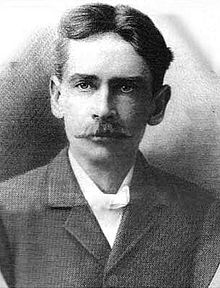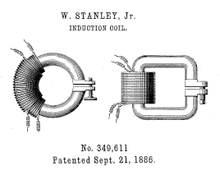Loading AI tools
American physicist (1858 - 1916) From Wikipedia, the free encyclopedia
William Stanley Jr. (November 28, 1858 – May 14, 1916) was an American physicist born in Brooklyn, New York. During his career, he obtained 129 patents covering a variety of electric devices.[1] In 1913, he also patented an all-steel vacuum bottle, and formed the Stanley Bottle Company.
William Stanley Jr. | |
|---|---|
 | |
| Born | November 28, 1858 Brooklyn, New York, U.S. |
| Died | May 14, 1916 (aged 57) |
| Education | Yale University (BA) |
| Spouse |
Lila Courtney (Wetmore) Stanley
(m. 1884) |
| Children | Harold Stanley |
| Awards | IEEE Edison Medal (1912) |
| Scientific career | |
| Fields | Electrical engineering |
| Institutions | General Electric |
| Signature | |
Stanley was born November 28, 1858, in Brooklyn, New York, the son of William Stanley and Elizabeth A. Parsons Stanley.[2] William Jr. attended Williston Seminary and later graduated from Yale University with the class of 1881.[2]
Stanley was as an electrician working with tele keys and fire alarms of an early manufacturer. In Philadelphia, Stanley designed one of the first electrical installations (at a Fifth Avenue store). Shortly thereafter, George Westinghouse hired Stanley as his chief engineer at his Pittsburgh factory.
In 1885, Stanley built the first practical alternating current transformer based on Lucien Gaulard and John Dixon Gibbs' prototype of 1881. This device was the precursor to the modern transformer. In December, under a new contract with Westinghouse, Stanley moved his operations to Great Barrington, Massachusetts.[3]
In 1886, on March 20, Stanley demonstrated the first complete system of high voltage alternating current transmission, consisting of generators, transformers and high-voltage transmission lines. His system allowed the distribution of electrical power over wide areas. He used the system to light offices and stores along the main street of Great Barrington - the location of his West Avenue family home. Stanley's transformer design became a prototype for future transformers, and his AC distribution system formed the basis of modern electrical power distribution. His work in the electrification of Great Barrington's Main Street was named an IEEE Milestone.[4]
Agreeing that the AC system had arrived, Westinghouse further tested the system in summer 1886 in Pittsburgh; it transmitted over a distance of 3 miles, and used an alternator designed by Stanley to replace the Siemens model, which regulated voltage poorly. Satisfied with the pilot system, Westinghouse began commercial production and shipped his company's first commercial alternator to Buffalo, New York, where a local utility placed it in service. Orders for 25 alternating-current plants followed within months.[3]
In 1890, Stanley founded the Stanley Electric Manufacturing Company in Pittsfield, Massachusetts. In 1903 the General Electric Corporation purchased a controlling interest in the firm. The land on which the company once stood is now the site of the William Stanley Business Park of the Berkshires in Pittsfield.[5]

William Stanley Jr. was granted 129 patents for a range of products and electrical devices.[1][6] A selection of patents follow. Significant patents are in bold.

William married to Lila Courtney (Wetmore) Stanley in 1884.[2] In 1935, their son, Harold Stanley, went on to found the modern day financial firm of Morgan Stanley with J. P. Morgan's grandson, Henry Sturgis Morgan.[8]
William Stanley Jr. died at his home in Great Barrington on May 14, 1916.[2]
Seamless Wikipedia browsing. On steroids.
Every time you click a link to Wikipedia, Wiktionary or Wikiquote in your browser's search results, it will show the modern Wikiwand interface.
Wikiwand extension is a five stars, simple, with minimum permission required to keep your browsing private, safe and transparent.